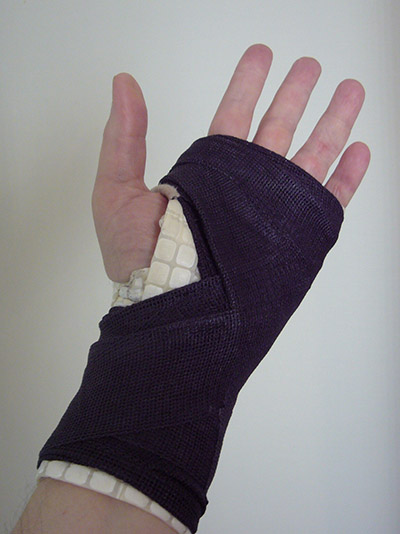
|
About a month ago, on Christmas Eve to be exact, I stumbled and fell on the sidewalk, landing on the side of my face and across the back of my left hand. Among other bangs and bruises, which have since healed, I broke three bones in that hand and wrist. Between the splint put on in the emergency room and the cast fashioned by the hand specialist—luckily, there was no need for corrective surgery—I now have limited use of those four fingers and the barest pinch between thumb and forefinger. Luckily also, I am right-handed. According to the hand doctor, the bones are not shifting and they are knitting well. But still, I may be another month or so in the cast and then a removable splint.
I try to treat everything as a learning experience. So what have I learned from this, other than to be more careful and watch my step? Well, for one thing, I have more understanding for those who, by accident or illness, have lost the use of their fingers or their whole hand. Here are the limitations—temporary limitations, I remind myself—so far encountered.
Typing: I am by training—self-taught from a typewriter manual one winter break during high school—and by nature a two-hand, ten-finger touch typist. No hunt-and-peck for me. So much so that being able to sit down and share my brain through my fingers is now part of my writing process.1 I can still type by spider-walking my right hand across the keyboard, using my left thumb or forefinger to hold down the occasional shift or control key. The result is barely faster than keying into the search function on your DVD player using the remote’s arrow pad. And I still hit the wrong key, or a combination of right and wrong keys, ten percent of the time. So writing is hard.2
Pockets: For fifty-odd years the distribution of daily necessities in my pants pockets has been: knife, comb (when I carried one), and handkerchief in right front; keys, coins, and sundry tokens in left front; wallet in left rear; nothing, or a washcloth for use as an emergency towel, in right rear. With my left hand encumbered by the cast, this time-honored practice goes out the window, and everything, stripped down to minimum, goes on the right side. I’m still fumbling around with this.
Child-proof caps: These devices of the devil, approved for medications taken by sick and feeble people, are impossible to work one-handed, even with the support of a few incompetent and weak fingers and a thumb on the other hand. Once I finally get a cap off, I leave it sitting lopsided on top of the bottle until I need to take another pill.
Zip-lock bags: They’re ingenious—until you realize they’re designed for two working hands with full grip strength. No combination of two fingers on one side, two on the other, can break the seal. The only way I can get them open is to pin one side against the countertop with my left thumb and grip and pull up the other side with my right hand. The contents only occasionally spill out all over the counter.
Buttons: Another ingenious device that really takes two hands. I can use my left thumb working against my cast to hold the buttonhole steady, if not partway open, then use all the fingers and thumb of my right hand to work the bottom edge of the button through the hole and try to anchor the top edge before the bottom slips out again. I can work the big buttons on a sweater, but I give up on all the tiny buttons on a dress shirt. So I wear mostly polo shirts these days. And sleeve buttons, right or left—forget it!
Jackets: Any garment, really, that does not have an expandable sleeve opening, like a winter coat with a knit cuff, blocks passage and traps the bulky cast. I’m too cold to wear my coat draped over the left shoulder, like a Hussar’s pelisse, and too frugal to cut open the seams of the left sleeve on a good coat for a temporary situation like this.
Knots: Unless I can use my teeth, knots are impossible. Shoelaces are hopeless. So I wear mostly slip-on sandals. And socks are hopeless, too. I can do a sloppy granny knot with something as big and thick as a bathrobe belt, but it doesn’t hold for long.
Zippers: I can work a zipper if it’s anchored at one end, like the fly in men’s trousers. But the open-ended version, like on a jacket, is impossible. I just can’t get the pin on one side inserted into the box on the other, manage to hold them both steady, and still pull up on the slider tab. So my jacket flies loose in the wind.
Manual transmission: Yeah, I’m driving a stick again, now that I’m not commuting 35 miles a day each way through heavy traffic. I traveled by Uber for the first couple of days after the fall, when my whole arm was in a splint. My cast now lets me take a light grip on the steering wheel while shifting; so I can still drive—but carefully. And sharp turns require a big over-and-under maneuver with my right hand; so I must plan ahead to avoid shifting while turning. The clutch lever on the motorcycle is hopeless, however, and I have no strength to hold onto the left grip, much less steer; so the bike is on a battery tender for a couple of months. Anyway, I can’t get my left arm into my leather riding jacket.
Personal grooming: Washing my face one-handed feels weird and incomplete. I can shower using a big rubber-and-vinyl glove that slips on over the cast, but then the cleaning process is mostly feeling around one-handed with the soap or washcloth, and my right side gets much less thorough attention than my left. Shaving and toothbrushing are no problem with modern electronic devices, but putting deodorant on my right armpit using only my right hand is an exercise in gymnastics. Luckily, I’m still flexible enough.
Heavy lifting: The hand specialist warned against this. Any use of my left thumb or fingers other than to steady a load in my right hand is perilous. Anything that tugs or pulls on those fingers—like holding the dog’s leash while I lock or unlock the door—risks moving the bones that are trying to knit, giving rise to an ominous ache. I still use the left hand in a limited fashion, but carefully and with occasional pain.
Living with one hand and a few weak fingers, everything is harder, it takes longer, and if I put any pressure on the broken bones or the wrist, it hurts. So life goes on—but at a much slower pace.3
1. I’ve tried the Dragon Naturally Speaking dictation software through a number of its upgrades. Ninety-five percent accurate is still one goofball error every twenty words, and the voice-correction protocol—required so that the software can learn from its mistakes—is painfully slow and irritating. Also, my mind just does not compose through the spoken word.
2. I once bought an ingenious little device called a Frogpad, a one-handed keyboard, but never learned to use it comfortably. The company now seems to be out of business. Pity—I could use it this time.
3. Given how difficult it is to type, and that the last few blogs were already written and in the can before the accident, this may be the last posting I can make for another month or so. I have to take these things one at a time.


